If one were to ask why one of the two original Mona Lisas has flanking columns, and the other does not, the logical answer is that they are two separate compositions – with certain deliberate similarities, and with certain distinct differences of which only the artist was aware – and never intended to be copies of each other.
Instinctively, when the two paintings are compared side-by-side, a natural reaction is to see the Louvre figure almost crowding-out her background, and to assume that the wood panel was at one time somewhat wider, thus allowing for the inclusion of a true set of columns or some other device, in order to frame the figure in a more likely special composition. What now passes for column bases and the barely-visible vertical strips on the Louvre ‘Mona Lisa’ were likely never part of the original composition. The actual painted surface of the Louvre portrait was never wider than it is today. This matter is dealt with in detail shortly.
Many eminent scholars have believed that the Louvre ‘Mona Lisa’ was once wider, to accommodate flanking columns:
- Kenneth Clark, in his letter to Murray Urquhart of 25th February, 1943, opines that columns evidently formed part of the original design (of the Louvre ‘Mona Lisa’).
- In 1959, the distinguished German art historian, Richard Friedenthal states that: “ … it [the Louvre ‘Mona Lisa’] was cut by about 10cm on each side.” That would have meant that the panel was wider by about 20cm, roughly 8 inches.”
- “The lady sits by the parapet of a loggia, which was originally extended at each side to include two columns framing the landscape, as in a window. These are now reduced to little more than vertical strips, but their bases are easily visible and their foreshortening offers the only element of linear perspective in the picture. Originally, then, the overwhelming presence of the lady was kept in check by the architectural structure of her setting.” (Carlo Pedretti: Leonardo – A Study in Chronology and Style, 1973)
Professor Pedretti here makes the strong point that the architectural structure of the Louvre ‘Mona Lisa’ would have been better served with columns to frame the composition. The ‘Earlier Mona Lisa’ has columns that can be clearly seen in their original state.
- In 1992, Serge Bramly wrote: “The panel has lost a strip of about seven centimeters from each side: we can no longer see the two columns that originally framed the landscape, which appear in old copies and in Raphael’s drawing.”
- In a subsequent book: Mona Lisa – The Enigma, author Bramly iterates: “Like so many of Leonardo’s works, the ‘Mona Lisa’ has suffered both from the ravages of time and from rough treatment by restorers: it has been narrowed by six or seven centimeters on both the right and left.”
- Professor Pietro Marani wrote in 2000: “She does sit between two columns that, because the panel has been cut down at the sides, are now scarcely visible at the very edges of the composition.” ”
- In 2005, John Paoletti and Gary Radke wrote: “At one time the figure was flanked by columns whose bases are part visible on the ledge behind her …”
- Martin Kemp in Leonardo da Vinci – The Marvellous Works of Nature and Man, 1981 [1st. Edition] states: “ … Leonardo has described the retaining wall of the high balcony and has given clear indications of the flanking columns in what was presumably a classical loggia. These two columns, as early copies confirm, were once more fully visible; the present panel has been insensitively trimmed on either side at some remote time in its history.”
However, all this conjecture was finally put to an end when, in October 2004, the Louvre ‘Mona Lisa’ was subjected to a battery of scientific and technical examinations, undertaken by a group of 39 international experts. In the reports (extracted from Mona Lisa – Inside the Painting, 2006) concerning the edges of the poplar-wood support, the evidence revealed that, over the centuries, the panel had actually been slightly trimmed on the sides, but only on the unpainted support. “Careful examination of the side edges in section reveals open burrow holes made by parasites, which indicate that the plank’s width was trimmed a second time … There is a crest, or ‘barbe’, of the ground preparation running all round the perimeter of the picture itself … this trimming clearly only involved the bare wood and not the paint layer … The absence of any ground preparation on the covered edge thus provides us with irrefutable testimony to the original dimensions of the painting itself…”
It also tells us that the supposition, that the columns that are now barely visible on either side of the image were originally more prominent but were cut back some time after the picture was painted, is mistaken.
The three main conclusions that emerge are [see Lorusso and Natali for an in depth discussion]:
1. that it is now clear that the Louvre ‘Mona Lisa’ never had flanking columns in its original composition;
2. that it therefore follows that for any version or copy of a Mona Lisa that does depict columns, the idea must have originated from a painting with such columns. The only painting known today that could be attributed to the master and that displays them is the ‘Earlier Mona Lisa’ and
3. that this confirms once again that the conception for the two compositions was deliberately different from the outset.
In addition, Professor Frank Zoellner, having had an opportunity to inspect the panel personally, writes: “This new evidence seems to support the suggestion that Leonardo painted two versions of Mona Lisa yet the possibility of a cartoon version with full columns is more likely.” However, it would seem far more reasonable to assume that Raphael and the many copyists depicting columns were in fact basing their work on another version and not a cartoon since Raphael’s sketch dates after Vespucci had seen the original and many copies were executed decades later. In fact, Vincent Delieuvin, curator at the Louvre, states that the sketch and these other copies must have been inspired by another version.
However, to this day, there is no record of any cartoon of the Mona Lisa executed by Leonardo.
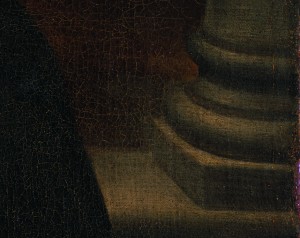
Right-hand column of the ‘Earlier Mona Lisa‘, superbly highlighting the classical architectural detail.
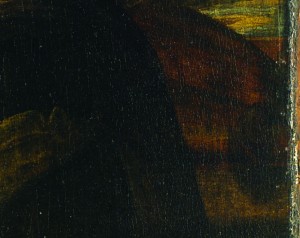
Right-hand column of the Louvre ‘Mona Lisa‘: the classical order of measurement here is not accurate.
With reference to the barely visible vertical lines and partly revealed column bases on the Louvre ‘Mona Lisa’, there are pointed criticisms. Initially, what is there today serves no significant purpose. It is therefore not impossible that these additions were not by the hand of Leonardo. Generally, the compositions of his paintings follow along strict mathematical principles, and certainly by the beginning of the 16th Century he had mastered the ability to depict anything he desired. Logically, if he had intended to frame the Louvre ‘Mona Lisa’ with columns, then he would have painted them properly and allowed space for them in the geometry of the structure, perhaps having in mind the unfinished earlier version or one of its copies.
“No human inquiry can be a science unless it pursues its path through mathematical exposition and demonstration.” Leonardo da Vinci
There is a distinct feeling that at some point in the painting’s history, some restorer felt that the portrait would be better served with the addition of slithers of columns, even if they could not be seen properly. However, it would appear that the slithers that are present are far removed from the standards of the master.
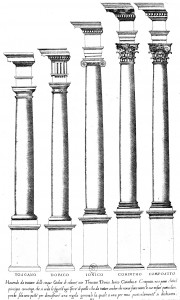
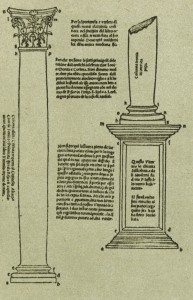 FROM WHERE DID THE IDEA OF THE COLUMNS COME?
FROM WHERE DID THE IDEA OF THE COLUMNS COME?
The inclusion of the columns is strongly suggestive of Leonardo’s hand and fits with his preoccupations at the turn of the 16th Century. Once again we see Leonardo the innovator. At that particular period in his life, the idea must have germinated from somewhere: he had never used this framing device in any of his previous portraits. If we retrace Leonardo’s footsteps, we can see evidence that his interest in these columns and that form of classical architecture would have created his passion for mathematics. It should also be understood that when Leonardo refers to mathematics, this reference would be different than in today’s context. There is little algebra or trigonometry here: Leonardo’s interest and practice manifests itself primarily through geometry. He is looking at perfect balance and proportion, and he uses his knowledge of architecture to create the perfect structure in his work.
When he fled Milan in 1499 with his friend and mentor, the great mathematician Fra’ Luca Pacioli, the pair eventually settled the following year in Florence, where they also lived together for a while. They had originally met at the court of Ludovico Sforza, where Luca was tutoring in mathematics. Luca was interested in the work and thought of Vitruvius, the Roman architect and engineer, who lived in the 1st Century B.C. Vitruvius believed in three central themes in architecture: strength, functionality, and beauty; a theory not lost on Leonardo. In addition, Vitruvius had written extensively on classical Greek architecture, in particular the Ionic order. Tragically, the brilliant Ferrarese architect, Giacopo Andrea, who had translated the works of Vitruvius for Leonardo, was murdered by the French in 1500, after their invasion of Milan. Now back in Florence, Leonardo had undertaken, among his other projects, to illustrate Luca Pacioli’s work De Divina Proportione, which was eventually published in 1509.
Therefore it is likely no coincidence that at that time Leonardo’s head is filled with images of Ionic columns, and with the timely commission to paint the portrait of the young Lisa del Giocondo, he would have taken the opportunity to innovate with their inclusion. Once again, the result is spectacular. When the column bases in the earlier portrait are compared with those in the Louvre version, the difference in quality is quite stark.
With specific reference to the four Mona Lisa versions under comparative analysis, the images below take an unusual look at the pairings of the bases of the flanking columns. The results are self-evident:
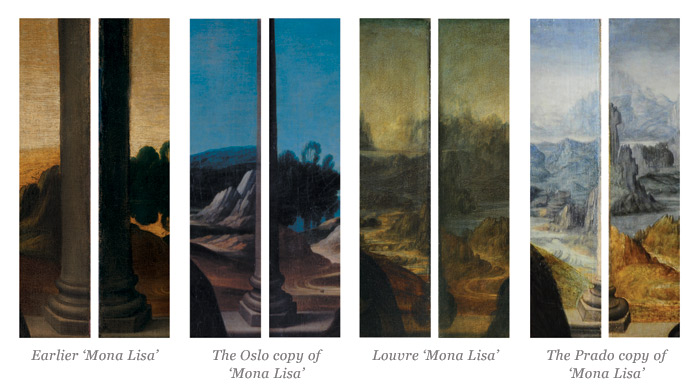 ‘Earlier Mona Lisa’: This has the best-formed pair of column bases of all the four paintings. The likelihood is that these columns were conceived, and probably sketched-in at the outset as they were painted prior to the landscape. The column on the left side of the figure in the portrait [the 2nd image from the left] does indeed throw the all-important requisite shadow onto the balcony ledge.
‘Earlier Mona Lisa’: This has the best-formed pair of column bases of all the four paintings. The likelihood is that these columns were conceived, and probably sketched-in at the outset as they were painted prior to the landscape. The column on the left side of the figure in the portrait [the 2nd image from the left] does indeed throw the all-important requisite shadow onto the balcony ledge.
Oslo ‘Mona Lisa’: As has been previously mentioned, the composition of this painting is almost exclusively based on the ‘Earlier Mona Lisa’. The columns and the bases are quite well drawn – not perfect – and at least show proper perspective. The volume of the pillars themselves is smaller, so they appear narrower, and with less substantial plinths. The landscape imagery is very similar to the earlier version, but the cluster of trees and some of the background hills are higher in the composition than in the earlier version. The rocky outcrop in the foreground landscape [images 3 and 4 from the left] is nearly identical in shape in both pictures.
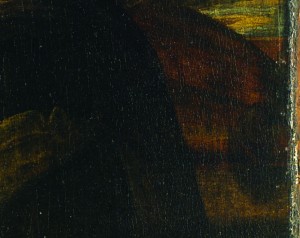 Louvre ‘Mona Lisa’: Leaving aside the missing shadow on the balcony ledge [this is discussed in detail shortly], one can get an idea of how poorly these elements were rendered, like shapeless blobs, with a different scale and perspective on each side. Furthermore, the column base to the right of the figure in the portrait [the 5th image from the left] was viewed under significant magnification. Through this, there is visual evidence that the columns were a later addition. Unlike the earlier version, the columns were likely painted after and on top of an existing landscape. The paint of the columns was so thin that some of the landscape work underneath could be seen from the surface. There is no proper underpainting under the column bases. That is not the way Leonardo worked; and would indicate that these bases, and the barely noticeable pillars, would likely not have been painted or even drawn in this fashion by one of the greatest artists who ever lived. Note also the mis-matching of the two halves of the plith. By contrast, the painting of the columns in the ‘Earlier Mona Lisa’ was intentional, and not executed on top of any pre-existing background.
Louvre ‘Mona Lisa’: Leaving aside the missing shadow on the balcony ledge [this is discussed in detail shortly], one can get an idea of how poorly these elements were rendered, like shapeless blobs, with a different scale and perspective on each side. Furthermore, the column base to the right of the figure in the portrait [the 5th image from the left] was viewed under significant magnification. Through this, there is visual evidence that the columns were a later addition. Unlike the earlier version, the columns were likely painted after and on top of an existing landscape. The paint of the columns was so thin that some of the landscape work underneath could be seen from the surface. There is no proper underpainting under the column bases. That is not the way Leonardo worked; and would indicate that these bases, and the barely noticeable pillars, would likely not have been painted or even drawn in this fashion by one of the greatest artists who ever lived. Note also the mis-matching of the two halves of the plith. By contrast, the painting of the columns in the ‘Earlier Mona Lisa’ was intentional, and not executed on top of any pre-existing background.
Prado ‘Mona Lisa’: As with the Louvre ‘Mona Lisa’, it is the columns that go a long way to spoiling an otherwise beautiful painting. Once again, there is no shadow from the left-hand column on to the balcony ledge (first image from the right). Also, as with the Louvre ‘Mona Lisa’, the two ‘halves’ of the plinth are not drawn to the same shape; nor to the same scale, nor to the same perspective. They look like a mis-matched pair.
CRUCIAL LIGHT AND SHADOW
As much as any other subject with which he was concerned with regarding the practice of painting, Leonardo attached enormous importance on accurately depicting light and shadow. He wrote profusely on this subject throughout the course of his career.

Another criticism of the columns in the Louvre ‘Mona Lisa’ is that there are no shadows. This detail is not a minor matter: it is a serious problem that likely points to those elements to not be by Leonardo. When one examines the column bases in the Louvre painting, it would seem that they do not accurately follow the rules of classical architecture, and are not even closely defined by light and shadow according to Leonardo’s own instructions.
In his Treatise On Painting, Leonardo states clearly:
“Shadows appear to me to be of supreme importance in perspective … Therefore, O painter, make your shadows darkest close to the object that causes it”.
“The light must be arranged in accordance with the natural conditions under which you wish to represent your figures; … If you represent them as within doors, make a strong difference between the lights and shadows, with shadows on the ground … Above all see that the figures you paint are broadly lighted and from above, that is to say all living persons that you paint; for you will see that all the people you meet out in the street are lighted from above, and you must know that if you saw your most intimate friend with a light [on his face] from below you would find it difficult to recognise him.” Leonardo da Vinci
“Lights and darks, together with foreshortening, comprise the excellence of painting … Lights and darks, that is to say, illumination and shadow, have an intermediate quality that cannot be called light or dark, but partakes equally of light and dark, or Shadows and lights are the most certain means by which the shape of any body comes to be known, or, Objects seen in light and shade will be displayed in greater relief than those which are wholly in light or shade.” Leonardo da Vinci
“As for his use of light, it seemed that Leonardo was always anxious not to portray it in all its brightness, as if wishing to reserve it for somewhere more appropriate. He also painted areas of shadow with a great intensity so as to maintain contrasts. Through these skillful means, he arrived at all that nature can achieve in his marvelous representation of faces and bodies. And in this respect he was superior to all, so that in one word we can say that Leonardo’s light was divine.” Gian Paolo Lomazzo
LEFT HAND COLUMN COMPARISON
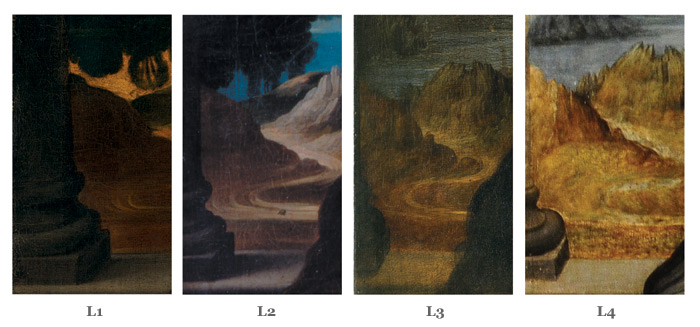
L1. ‘Earlier Mona Lisa’: In this painting, the column and its base are clearly part of the original composition, and not an afterthought. Furthermore, in accordance with Leonardo’s instructions regarding light and shade, the shadow from the column falls gently on the balcony ledge.
L2. Oslo ‘Mona Lisa’: This painting has copied the details and composition of the ‘Earlier Mona Lisa’, including a substantial column and plinth, requisite shadow on the ledge, and most of the landscape, including the unique stand of trees.
L3. Louvre ‘Mona Lisa’: The barely-visible column and column-base on the left appear to have been a later addition, and not in Leonardo’s composition of this portrait. The plinth is very poorly rendered, and there is no shadow on the balcony ledge.
L4. Prado ‘Mona Lisa’: The column-base is more shapely than the Louvre version it is purported to copy, and again, the critical shadow on the balcony ledge is missing.
“If the painter then avoids shadows, he may be said to avoid the glory of the Art and to render his work despicable to real connoisseurs.” Leonardo da Vinci
RIGHT HAND COLUMN COMPARISON
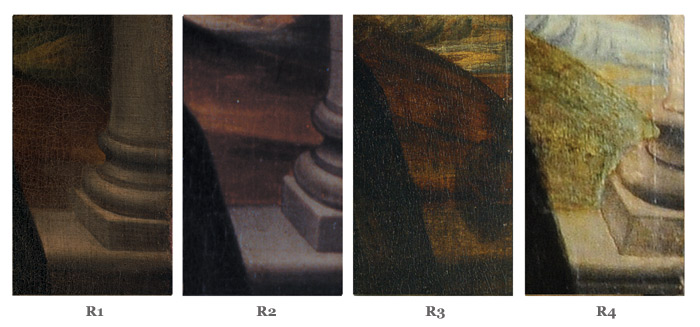
R1. ‘Earlier Mona Lisa’: Of all the versions and copies of Mona Lisa that display columns in their flanking compositions, this right-hand column and plinth demonstrate confidence of design and knowledge of classical architecture. It is argued here that this painting is the true genesis, not only of other Mona Lisa works displaying flanking columns, but also stood as a model for some of Raphael’s early 16th Century work.
R2. Oslo ‘Mona Lisa’: As with the left-hand side of the painting [L2], the copyist faithfully reflects the composition with flanking columns, as well as the Florentine landscape of the ‘Earlier Mona Lisa’.
R3. Louvre ‘Mona Lisa’: On this right side also, the column is barely noticeable, and the plinth base provides evidence that it was painted over the landscape, and therefore likely was not part of the original composition.
R4. Prado ‘Mona Lisa’: Again, there is ample evidence, including the bridge, that this copy was based on the Louvre version. However, the details of the plinth are shaped differently than its left side counterpart, and its perspective is not accurate.